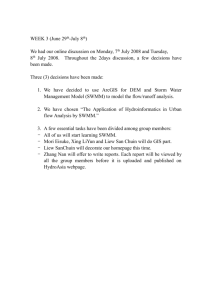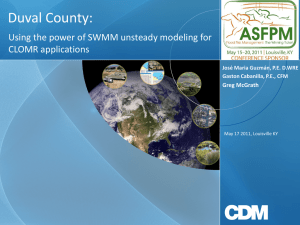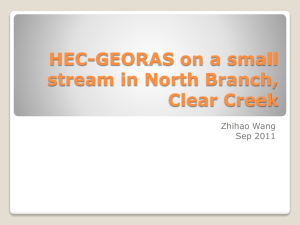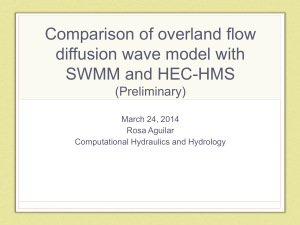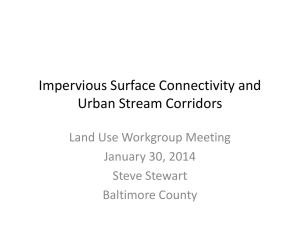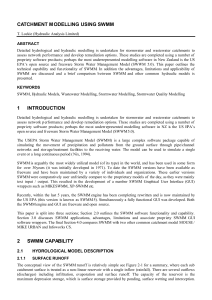Accounting for Both Storage and Conveyance
advertisement
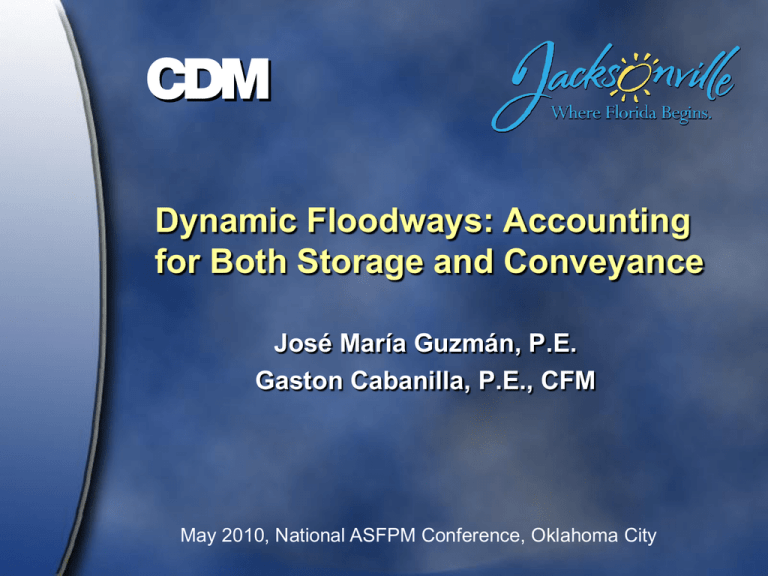
Dynamic Floodways: Accounting for Both Storage and Conveyance José María Guzmán, P.E. Gaston Cabanilla, P.E., CFM May 2010, National ASFPM Conference, Oklahoma City Outline Standard FEMA methods to develop a floodway Accounting for storage using SWMM Application to Jacksonville, FL (Duval County) DFU: A computational tool Discussion of floodway results Acknowledgments: Tom Nye, Sandeep Gulati, Seungho Song, Michael F. Schmidt, Zhida Song-James Floodway Definition Based on FEMA Regulations FEMA’s regulations (Section 59.1) state: “A floodway is defined as the channel of a river or other watercourse and the adjacent land areas that must be reserved in order to discharge the base flood without cumulatively increasing the water-surface elevation by more than a designated height. ” Floodway Definition Based on FEMA Regulations (cont.) In the State of Florida the “regulatory” floodway is based on a maximum allowable one foot rise in the BFE when the floodplain is encroached through the flood fringe The USACE Developed Several Methods to Establish a Floodway Methods were developed with the use of HEC-2 In general there are five methods available 1 • User enters right and left encroachment stations 2 • User enters fixed top width 3 • User specifies the percent reduction in conveyance 4 • User specifies a target water surface increase 5 • User specifies a target water surface increase and maximum change in energy HEC-RAS Includes Tools to Run the Floodway Development User can select from among the five methods developed by the USACE The model generates the floodway encroachments When Not Using HEC-RAS, the Options are Limited In the particular case of SWMM, FEMA guidelines suggest using the HEC-RAS tools: 1. Convert the model to a steady flow model such as HEC-2 (or HEC-RAS) to compute encroachment stations using the equal conveyance method When Not Using HEC-RAS, the Options are Limited (cont.) In the particular case of SWMM, FEMA guidelines suggest using the HEC-RAS tools: 1. Convert the model to a steady flow model such as HEC-2 (or HEC-RAS) to compute encroachment stations using the equal conveyance method 2. Apply the encroached transects to the SWMM model to compute the water surface elevations to account for the loss of floodplain storage When Not Using HEC-RAS, the Options are Limited (cont.) In the particular case of SWMM, FEMA guidelines suggest using the HEC-RAS tools: 1. Convert the model to a steady flow model such as HEC-2 (or HEC-RAS) to compute encroachment stations using the equal conveyance method 2. Apply the encroached transects to the SWMM model to compute the water surface elevations to account for the loss of floodplain storage 3. If there is greater than the allowable increase (one foot) in any of the cross sections, go back to the HEC model and get new encroachment stations CDM was contracted to update the 1989 FIS in Duval County, FL using SWMM The project was developed in SWMM for several reasons: • • • • Extensive previous models Successful model field verifications Flat terrain and tidal influence Integrated model that solves the entire system as once and not as individual branches • Upcoming water quality applications related to concurrent TMDL studies Applying the criteria set by the FEMA standard, CDM used SWMM as follows: Instead of iterating between HEC-RAS and SWMM, we developed criteria to develop floodway in SWMM Method 4 was selected (Specified Floodway Surcharge) The original concept consisted of comparing two stream geometries and determining the differences in water surface elevation Main differences with HEC-RAS • Both geometries are evaluated as part of the entire model (networked model) • Both models are run for the 100-year/24-hour storm (dynamic model) The Channel Geometry is Modified by the Engineer by Introducing Channel Encroachments KL 2/3 1.49 AL RL nL KR 2/3 1.49 AR RR nR The Engineer Computes the Conveyance Reduction on Both Sides, and Makes Sure That They are Equal 2/3 1.49 KL AL RL nL KR 2/3 1.49 AR RR nR K is a Function of the Wet Perimeter, Cross-sectional Area, and Channel Roughness Cross-Section Example Proposed 80 78 76 Elevation (ft) 74 72 70 68 Existing Natural Channel 66 Floodway 64 1% Annual Chance WSE 62 Main Channel 60 200 300 400 500 600 Station (ft) 700 800 900 1000 The Process Becomes a Series of Tests Where Comparing Two Conditions • Run Model • Observe Qn, WSEn Existing Condition Encroached Condition • Run Model • Observe Qe, WSEe • Conveyance • Surcharge Verification of Basic Criteria The Model Accounts for the Loss of Storage Associated with the Encroachments because it evaluates all the model cross sections at once Increased Complexity Took the Team From the Basic Concept to the Development of a Dynamic Floodway Utility (DFU) RUN SWMM • DOS Version EPA SWMM 5.12 DFU screens model output • • • • • • Read SWMM INP file Read SWMM RPT file Compares peak stages to BFE Sets encroachment percentages for next run Edits transect data to encroach cross-section Re-writes SWMM INP file with new encroachment Iteratively in DOS batch file 1. Run the 1% annual chance flow with natural channel geometry 2. Observe the following results from the simulation period: - Peak flow Qn (natural channel) WSEn (natural channel) 3. For each reach, move transect stations inward to the intersection with WSEn, set the encroachment percentage to 10% 4. Set N = 0 5. Iteration - N - modify model geometry based on a percentage encroachment for each side 7. Determine conveyance reduction for the left and right side of the transect: KL, KR 12. Compare each reach's surcharge (at us and ds nodes) to maximum surcharge - increase or decrease percentage encroachment as necessary (negative possible) 8. Select the minimum value between KL and KR. Adjust the other station to ensure that KL = KR. 9. Run model again for the 1% annual chance storm with adjusted transects 10. Observe the following values for the simulation period: - Peak flow QF (floodway) - Peak WSE at each node WSEF (floodway) NO 13. Is the average surcharge for all reaches > threshold*, < =1 ft, or are both sides encroached to main channel, or is the encroachment fixed by a ds node? YES 14. Prepare floodway table 11. Calculate the difference in peak WSE (surcharge) at every node N = Iteration index KL = Left conveyance KR = Right conveyance WSE = Water surface elevation * Threshold may be defined by user: in this project we used 0.6 6. If any of the new proposed stations encroaches beyond the existing channel banks, set the encroachment station to the existing bank 13a. N = N + 1 DFU Convergence Criteria One of the following criteria must be met for each cross section in the floodway mapping portion of the model: The cross section’s increase in peak stage (average of upstream and downstream node stages) should be between a threshold (0.6 ft) and 1.0 ft Both sides of the cross section are encroached to the bank of the main channel The cross section encroachment has been set back by an increase in a downstream node The Following Data are Given in a Text File to the DFU List of cross sections that are part of the floodway analysis, including: • Priority level (main branch and then tributaries) • Cross section position within each level, so the tool can read what sections are upstream from a given position – without having to decipher SWMM connectivity • Main channel stream bank positions – limits encroachment DFU – Batch File Structure @echo off set E1=0 set E0=0 :E0 echo Iteration %E1%%E0% swmm5 CF_2006_100_%E1%%E0%.inp CF_2006_100_%E1%%E0%.rpt floodwayv3 CF_2006_100_%E1%%E0%.inp CF_2006_100_%E1%%E0%.rpt if %E0%==9 goto E1 if %E0%==8 set E0=9 if %E0%==7 set E0=8 if %E0%==6 set E0=7 if %E0%==5 set E0=6 if %E0%==4 set E0=5 if %E0%==3 set E0=4 if %E0%==2 set E0=3 if %E0%==1 set E0=2 if %E0%==0 set E0=1 :E1 set E0=0 if %E1%==9 goto Done if %E1%==8 set E1=9 if %E1%==7 set E1=8 if %E1%==6 set E1=7 if %E1%==5 set E1=6 if %E1%==4 set E1=5 if %E1%==3 set E1=4 if %E1%==2 set E1=3 if %E1%==1 set E1=2 if %E1%==0 set E1=1 goto E0 goto E0 :Done The Engineer Reviews a Summary Table Generated by the DFU Cross Section Level maxDiff aveDelta Left encr Rate Right encr Rate SW40002 1 1.03 0.42 100.0 43.2 SW40005FP 1 1.03 0.71 0.0 0.0 YES SW40006FP 1 1.03 0.68 100.0 100.0 YES SW40007 1 1.03 0.81 100.0 38.5 YES SW40011 1 1.03 0.80 100.0 78.2 YES SW40012 1 1.03 0.89 0.0 0.0 YES SW40013 1 1.03 0.88 67.7 83.7 YES SW40014L1 1 1.03 0.93 100.0 57.8 YES SW40014L2 1 1.03 0.89 98.2 65.2 YES SW40015 1 1.03 0.91 58.3 100.0 YES SW40017 1 1.03 0.92 82.6 100.0 YES SW40025 1 1.03 0.59 100.0 100.0 NO YES SW40034 2 1.03 0.19 0.0 0.0 NO NO SW40035 2 1.03 0.16 0.0 0.0 NO NO SW40036 2 1.03 0.12 0.0 0.0 NO NO SW40037 2 1.03 0.07 0.0 0.0 NO NO >= 0.6 @Stream Banks Results are Then Presented in the Floodway Data Table Once the User is Satisfied With the Floodway Outcome, the Team Translates It into a Graphical Delineation Cross-sections need to be accurately identified in the map The encroachment stations are identified along the cross-section In the future, SWMM should improve the depiction of cross-sections to allow easy identification of floodway points in the map FEMA Has Been Involved in the Process Through a Series of Memoranda FEMA staff are interested in the results of the dynamic methodology Main FEMA concerns Added criteria for floodplain storage Many engineers have expressed concerns with the current steady application in some states Having a standard methodology that other engineers can use to replicate results Manual Corrections to Dynamic Floodway There are instances in which the dynamic floodway is too narrow or too wide due to hydraulic considerations In these cases, the user should overwrite the floodway using engineering judgment The user should understand the interdependence of adjacent cross-sections Floodway Review at bridges and culverts Wide FW Narrow FW Floodway Review at Confluence of Multiple Streams Rasplot Software Was Used to Generate Profiles Specific to SWMM That Display the Nodes Instead of Cross-Sections FIRM panel format based on link-node models such as SWMM Conclusions SWMM has been successfully utilized to prepare floodways for FEMA FISs without conversion to HEC-2 or HEC-RAS A DFU tool has been developed to aid in the placement of encroachment transects in the SWMM input file and to compare model peak stages to the base condition The tool runs iteratively in a DOS batch file. No modifications were made to the standard SWMM engine. FEMA has approved the methodology for the Duval County, FL FIS Future integration of the DFU into the SWMM GUI is desirable to facilitate widespread use Dynamic Floodways: Accounting for Both Storage and Conveyance José María Guzmán, P.E. guzmanjm@cdm.com May 2010, National ASFPM Conference, Oklahoma City Additional Challenges for SWMM Users in Mapping WSE not reported at cross-sections Cross-section locations are not included in the model Meandering channels Viewing the WSE in the cross-sections 80 75 70 Natural Channel 65 60 200 400 600 800 1000
